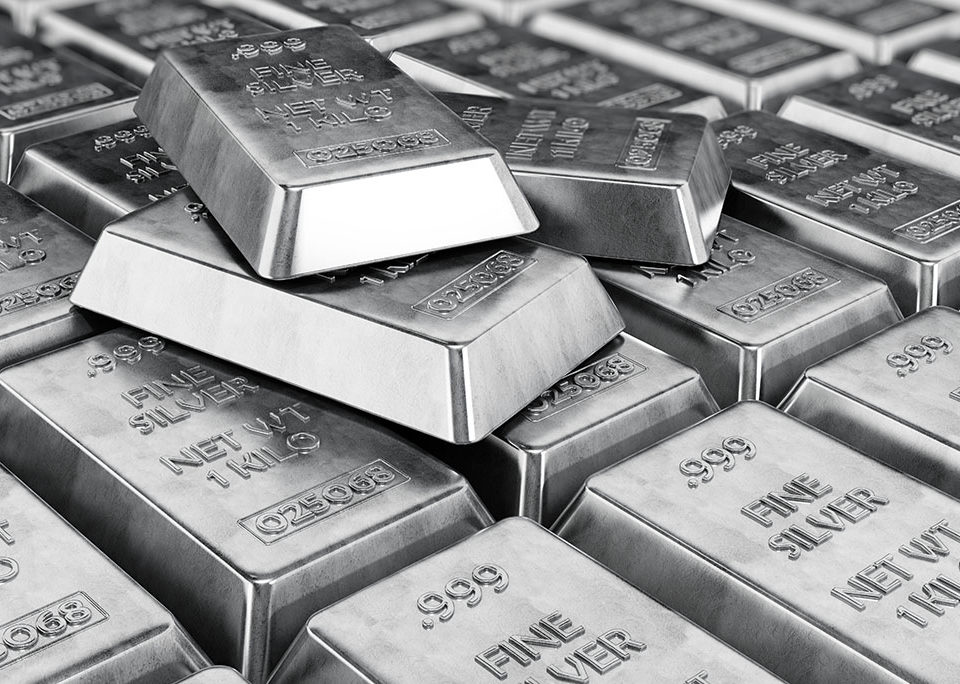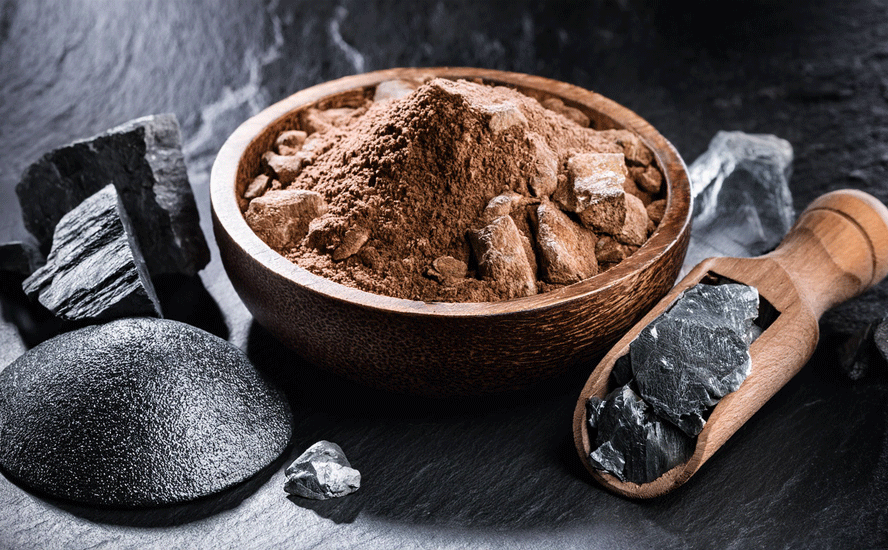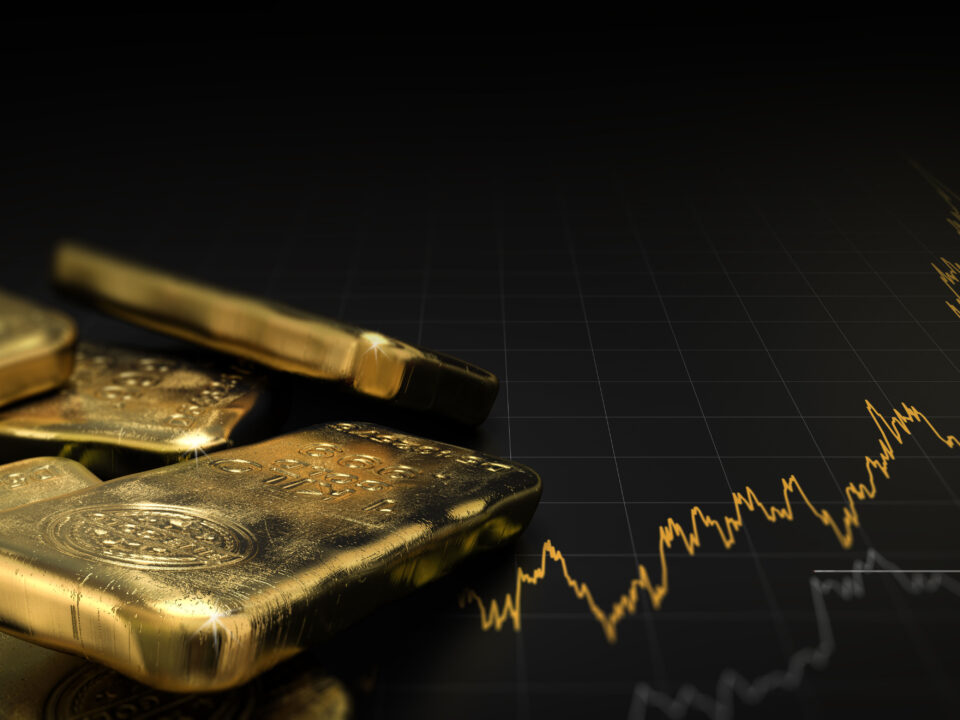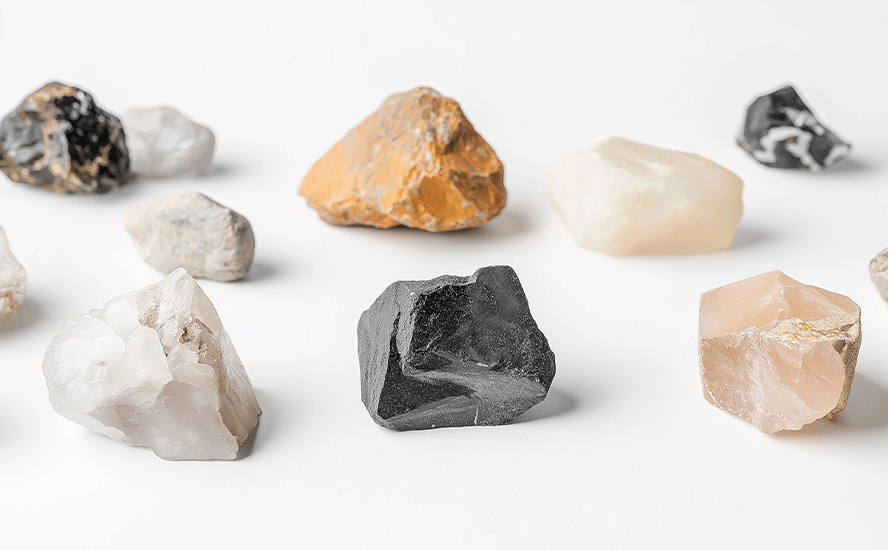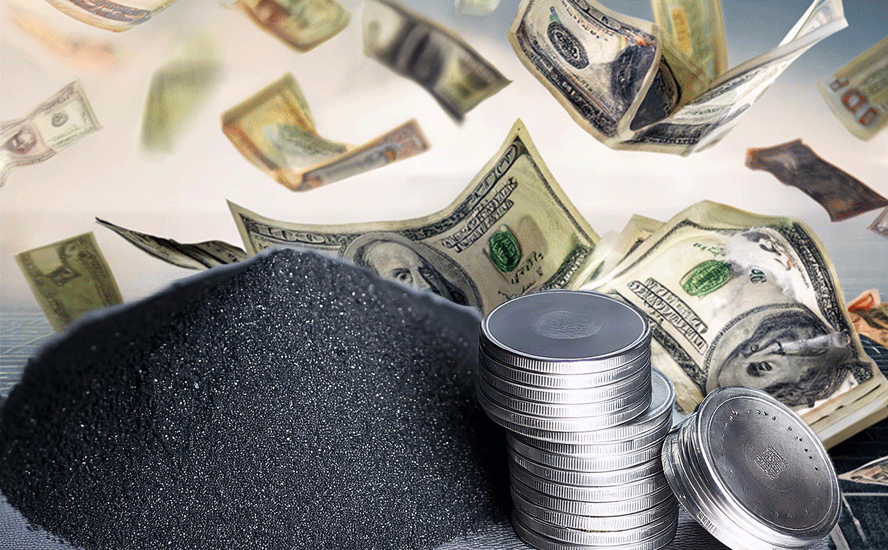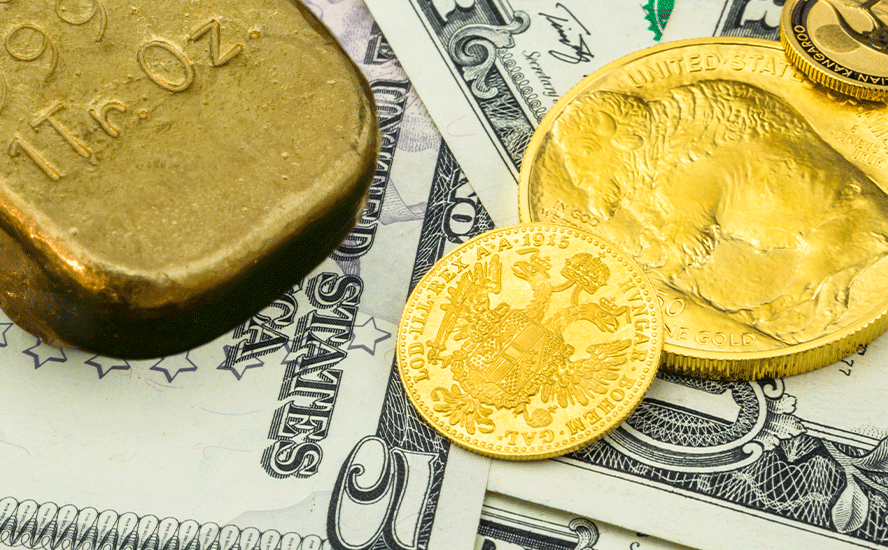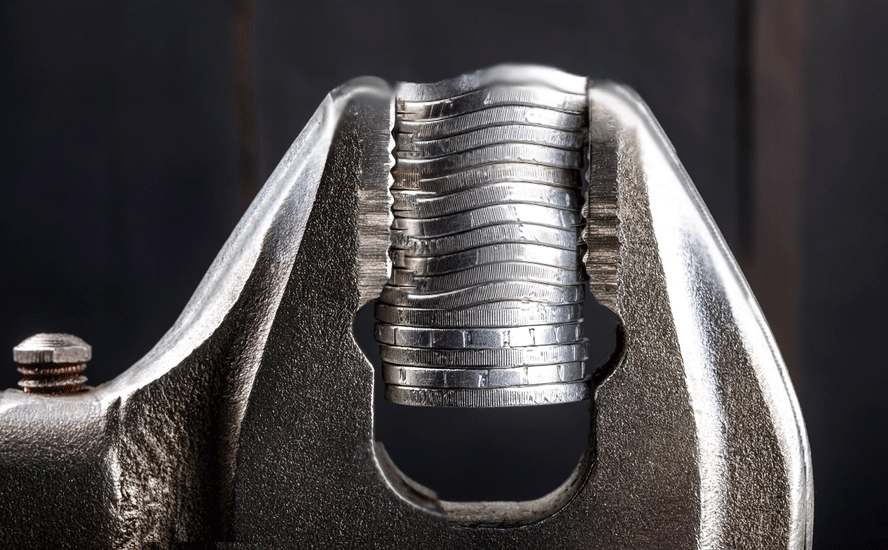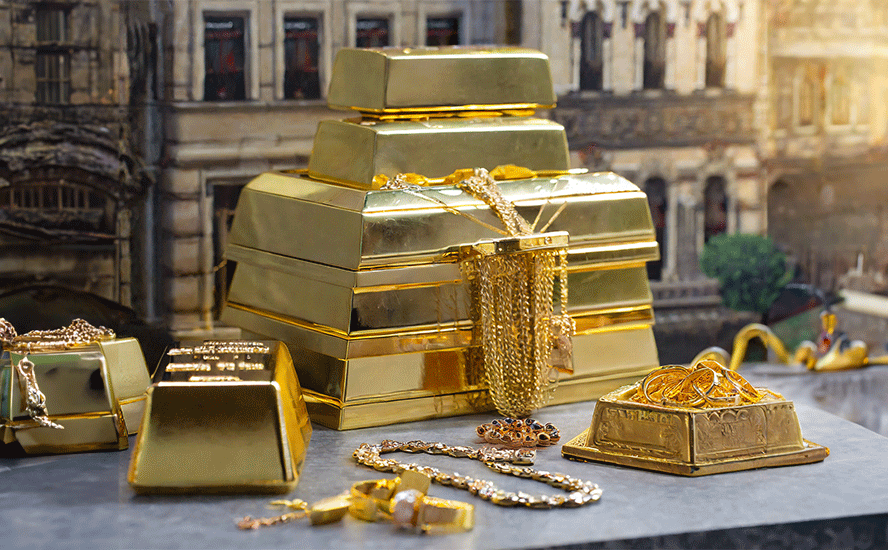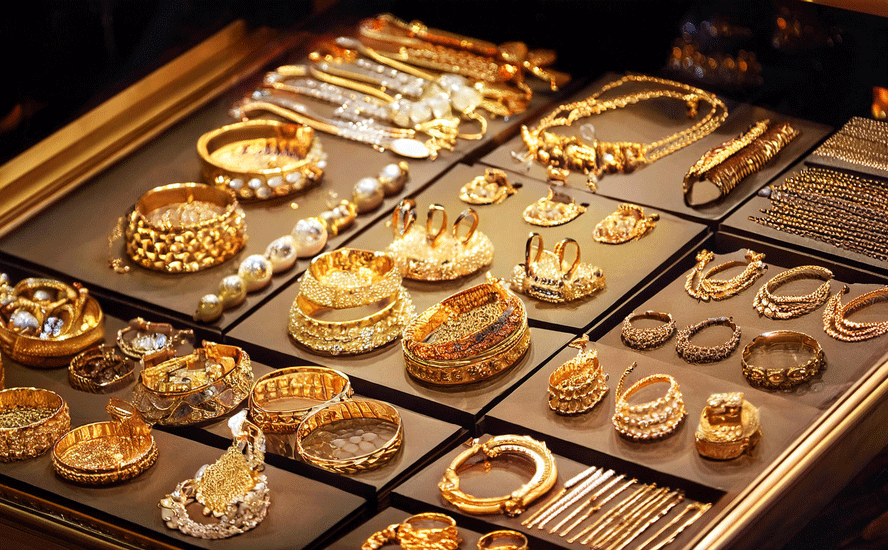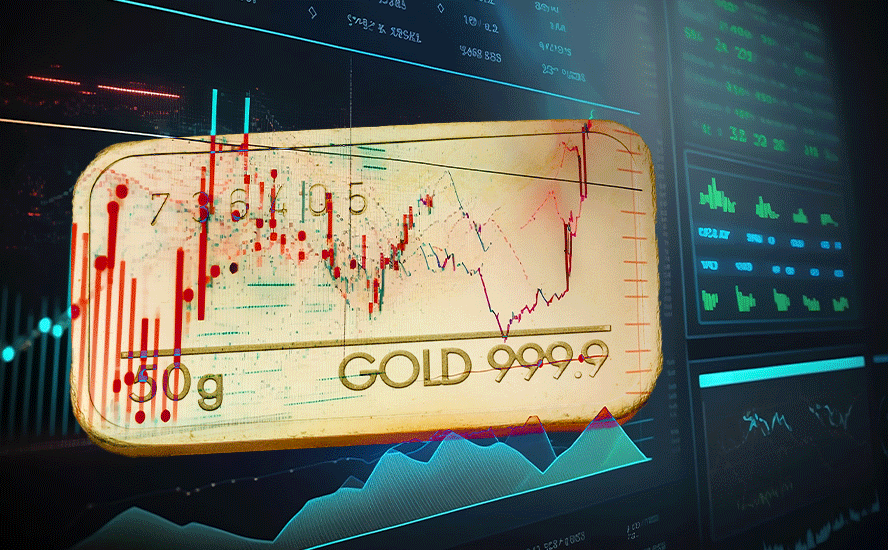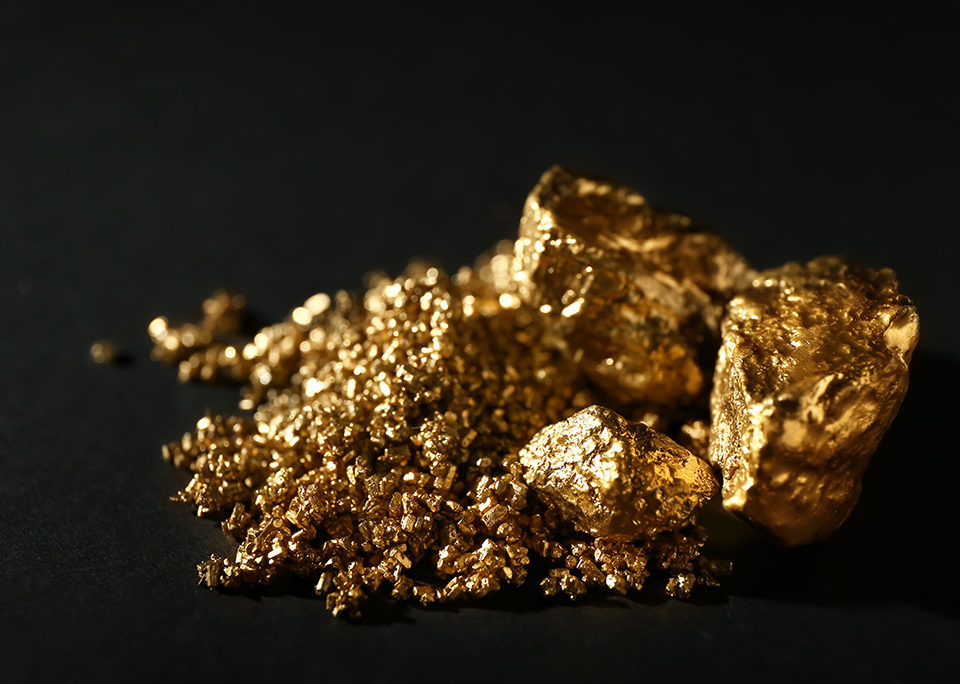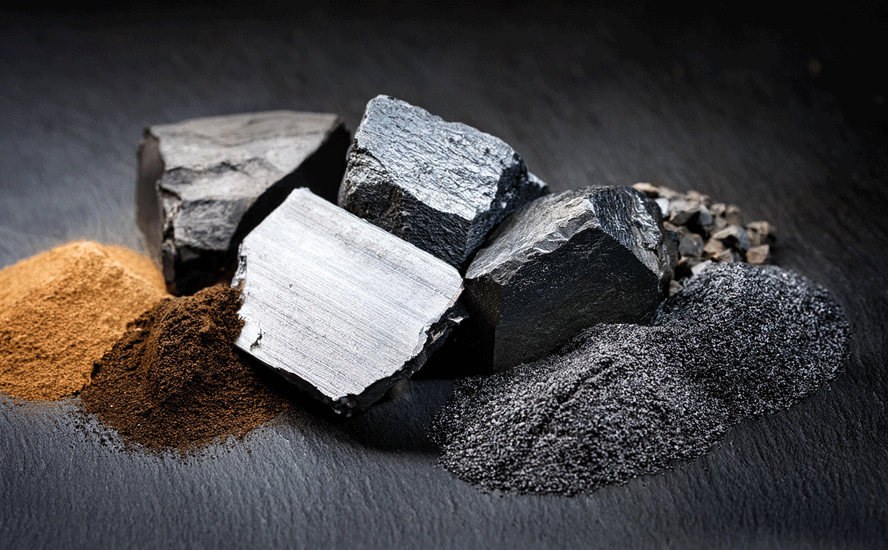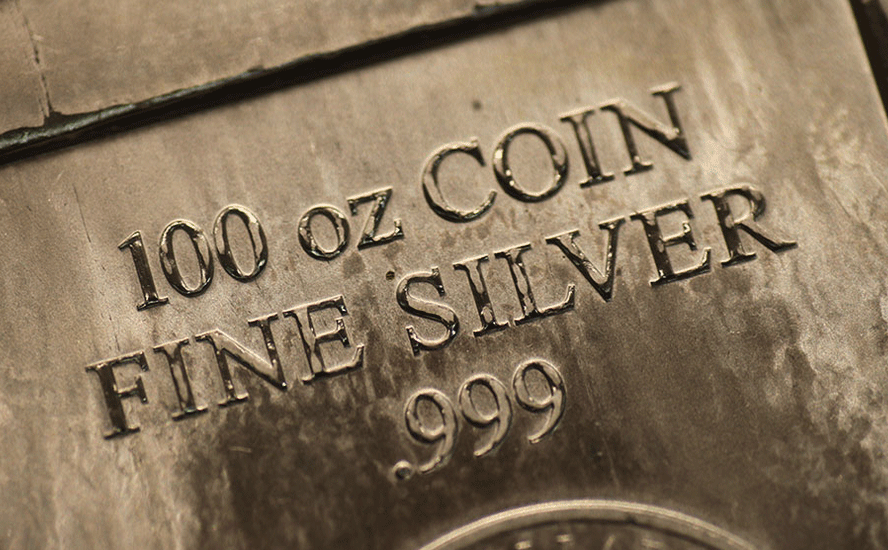Gold bull run still intact

2019.04.18
At Ahead of the Herd we love gold (and promising junior gold companies) because gold holds its value through time. Owning gold is a way to preserve wealth against paper currencies which are subject to inflationary pressures and over time, lose their value. In the US there was an increase in inflation for every decade except the Depression when prices shrunk nearly 20%. Between 1860 and 2015, the dollar experienced 2.6% inflation every year, meaning that US$1 in 1860 was equivalent to $27.80 in 2015. This also means that prices in 2015 were 2,828% higher than they were in 1860.
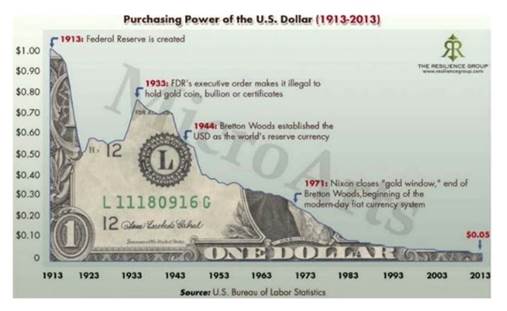
Gold investors love nothing more than a war, economic crisis or any type of geopolitical instability to watch the value of their bullion grow. Heightened global tensions such as terrorist attacks, border skirmishes or civil wars scare investors into putting their funds into safe havens like gold and stable, high-yield sovereign debt. Geopolitical tensions also drive more government spending (eg. on arms), which brings inflation, leading investors to look at precious metals as a place to park their money, short term.
For example during the 1970s, which saw a number of upheavals in the Middle East including the Iranian Revolution, the Iran-Iraq War, and the Soviet invasion of Afghanistan, gold rose 23% in 1977, 37% in 1978, and 126% in 1979, the year of the Iranian hostage crisis.
Gold is also bought as a hedge against what investors see as government policies that drag down the dollar and create inflation. In other words, gold is an economic safe haven. The most obvious example is the quantitative easing programs imposed by the United States, the European Central Bank and Japan. During QE the central bank “prints money” by adding credit to its member banks’ deposits, which has the effect of increasing the money supply, creating inflation. Between December 2008 and October 2014, the US Federal Reserve added $4 trillion to the money supply by buying Treasuries from its member banks.
The other concern that drove investors into the arms of precious metals during this period was the exorbitant spending by the US government, which hiked the debt to GDP ratio above 77%. An increase in debt not only causes inflation but sinks the dollar; when the dollar falls, gold usually climbs.
We also like gold because gold companies and explore-cos are finding less of it. All the easiest gold to mine has been found, including gold found near surface and in underground veins. We are now facing “peak gold” where gold production from here-on will keep falling. The experts agree the industry is seeing a significant slowdown in the number of large deposits being discovered. It used to be that major gold miners were looking at 5-million ounce projects to buy and develop; now they’d be happy with a million ozs in the ground.
Taking a run through the headlines, we find that despite recent price weakness, the gold bull market remains firmly intact.
Technical analysis
The gold price is tightly correlated to the US dollar, with the two almost always moving in opposite directions. Because there is so much volatility, wide price swings up or down, the longer the time frame the tighter the correlation. The charts below show a 10-year USD chart and a 15-year gold price chart. We can see that over the past decade, the US dollar index has risen from 73 to the current 97 against a basket of other currencies, or an increase of 32%. Gold on the other hand rocketed from $739 in November 2008 to an all-time high of $1895 in September 2011 – corresponding roughly to the US Federal Reserve’s quantitative easing (QE) program.
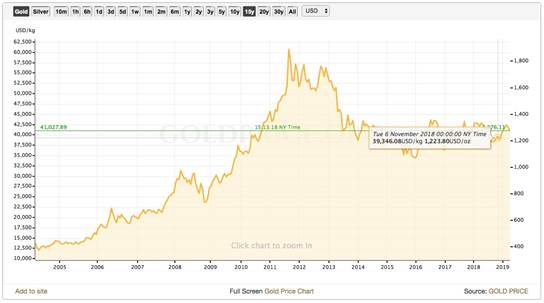

Gold then declined steadily to $1076, where it formed a bottom in December 2015. The precious metals since last summer has enjoyed a remarkable comeback. Linking the trough of $1175 in August 2018 to the Tuesday’s close of $1276, shows a 7.9% gain.
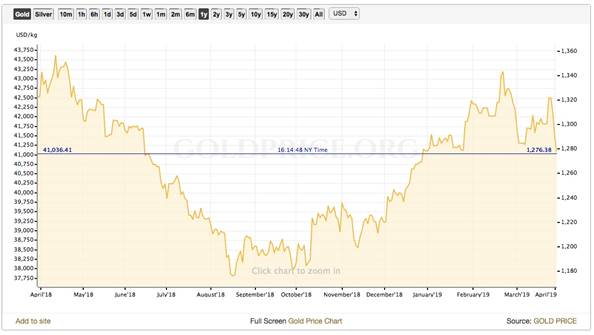
Drawing a line under the lowest points of the 15-year gold price chart shows the precious metal rising from $739 in August 2008 to $1070 in December 2015 – a gain of 44%. If we continue up the line to September 2018, when gold bottomed at $1193, we are talking about a 61% increase, within a decade. And that includes the financial crisis of 2008-09.
Economic slowdown
So far we’ve covered gold’s safe haven status, its relationship to inflation and the dollar, alluded to “peak gold” and plotted its price chart. Uncomplicated technical analysis shows that despite high volatility over the last decade (155% increase from trough to peak and 75% decrease from peak to trough), gold has provided a solid 61% return for somebody who bought gold in 2008.
Now we turn our attention to the current economic environment particularly in the United States which heavily influences the gold price. We find the country on the brink of a recession as shown by some key indicators.
The possibility of a further slowdown in China, along with negative fallout from the trade war between the US and China, are the two biggest risks to the US economy according to fund managers.
Those same fund managers are positioning clients’ portfolios for slower growth and lower interest rates. According to a new survey by Bank of America Merrill Lynch, 53% believe the US Federal Reserve is done raising interest rates (a raise showing confidence in the economy) and 66% seeing both low economic growth and low inflation. Reporting survey results, CNBC said 70% of fund managers expect a recession to begin in the second half of 2020.
Economists are almost as bearish. In a March poll by Reuters, 25% said they see a chance of recession in the US over the next 12 months. Worsening economic indicators, like the Fed backtracking on an earlier plan to raise interest rates this year, are making online lenders more cautious.
Digging a little deeper into the trade war and falling Chinese growth, we find that Trump’s trade war has found the president on the losing end. Writing a column for Bloomberg, Noah Smith, an assistant finance prof, states that raising prices for Chinese imports increased prices for consumers and factories – with losses to the economy in the tens of billions of dollars a year.
Among the worst hit: farmers. China slapped countervailing duties on US agricultural products, making them more expensive to Chinese buyers. The country eventually stopped importing soybeans from the US Midwest, causing inventories to pile up, farm incomes to decline and in some cases, bankruptcies. Trump had to respond with a $6 billion bailout package.
Smith writes:
This demonstrates why China was always in a better position to win a trade war with the U.S. China’s autocratic regime is much less vulnerable to the shifting winds of politics than the U.S.’s democratically elected politicians. Also, China much more recently escaped from poverty, and its residents are more accustomed to enduring economic hardship. And since China is still catching up with the rest of the world, a slowdown there means going from 6.5 percent annual growth to 6 or 5.5 percent, while a slowdown in the more mature U.S. economy means a significant hit or even a halt to growth.
In fact the slowdown in China may be worse than we think according to a recent Barron’s piece. It quotes a paper from the University of Chicago and the Chinese University of Hong Kong saying that the government has been overstating output numbers. The reason is that local government officials, who report their production stats to the central government, have a strong incentive to cheat, since promotions depend on hitting targets.
The official numbers have been systematically overstating economic output since 2008. They estimate that China’s real gross domestic product was about 15% lower than reported in 2016, and that the discrepancy has likely widened since then.” – Barrons.
In 2018 China’s economy grew at just 6.6%, the lowest level in 28 years. This affects the US economy; the United States exports some $200 billion to a year to the Asian nation.
Along with slack growth, the debt to GDP ratio, another key economic indicator, is also worsening.
The Chinese have always been considered better savers than North Americans, but that is starting to change as the middle class expands and gets lured into credit. Debt owned by China’s governments, households and businesses more than doubled from 146% of GDP in 2007 to 253% at the end of last year, Barron’s said.
As for improving the US trade deficit with China – one of Trump’s chief complaints and rationales for a trade war – it’s been a dismal failure. In March the trade gap with China hit a new high of $419.2 billion in 2018, compared to the previous record of $375.5 billion in 2017, Politico reported.
Interest rate climb-down
As far as the economy’s relationship to gold, of course the closest correlation is what’s happening with interest rates and the bond market. Gold traders closely follow the yield curve on US Treasuries to gauge the mood of bond investors. If the interest on short-term bonds falls below the rates on long-term bonds, that signals a lack of confidence in the economy and historically, has meant a recession is coming. As noted at the top, the gold price loves bad economic news, because investors flock to precious metals to safeguard their hard-earned capital.
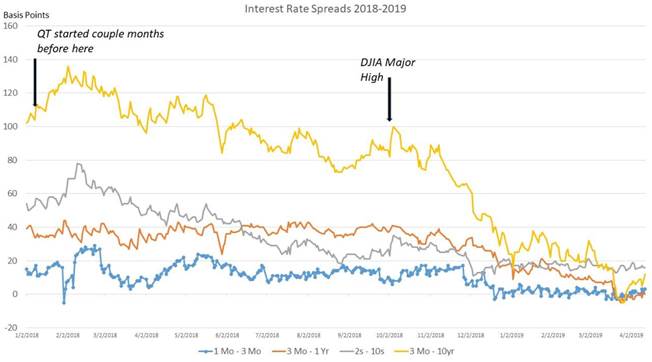
Seeking Alpha – Is something different this time?
Normally the “yield curve” slopes upward, because the longer the term, the more interest the T-bill must charge to attract investors.
While the yield curve isn’t currently “inverted”, an invert occurred on March 20.
Following the US Federal Reserve’s decision not to raise interest rates any higher in 2019, yields for the 3-month bond rose to 2.478%, versus a respective 2.39% for the 2-year and 2.31% for the 5-year. These don’t seem like large differences, but it’s all about perception.
The yields on two key long-term bonds, 10-year and 30-year, dropped, by a respective 2.519% (-8 basis points) and 2.957%. In fact the 10-year yield plummeted to a 14-month low, showing that earlier fears of a recession, when the yield curve inverted in December, are getting downright scary.
Interest rates are an equally important determinant of the gold price.
The US Federal Reserve’s decision in March not to hike interest rates this year was very bullish for gold. Instead the Fed will hold the benchmark rate at between 2.25 and 2.5%, and will also stop “shrinking its portfolio” in September.
The central bank was regularly allowing billions worth of bonds to run off its balance sheet, in order to reduce the $4.3 trillion in purchases of Treasury bills and mortgage-backed securities (MBS) it racked up through quantitative easing. In other words, it’s been reducing the size of its balance sheet by not replacing maturing Treasuries and MBS.
In the days following the Fed’s two-pronged announcement, gold ran up $21/oz.
“Rates are now seen peaking at 2.6 percent, sometime in 2020, roughly a percentage point lower than the historic average for the fed funds rate and a sign that the U.S. economy has entered a more sluggish era,” Reuters said at the time.
Tier 1 capital asset
These are the main factors (the dollar, interest rates, inflation, bond yields, economic growth) that investors need to examine when considering a gold trade. Equally interesting though are less quantifiable factors. At Ahead of the Herd we’ve been writing about these recently.
Among the most bullish developments for gold was making the yellow metal a “Tier 1 capital asset” that can help measure the stability of a bank.
After the financial crisis, new banking rules known as Basel I, II and III came into effect. The regulations require banks to maintain proper leverage ratios and to meet certain minimal capital requirements. Tier 1 capital assets, such as common stock and retained earnings, are considered the core measure of a bank’s financial strength from a regulator’s point of view.
Under the old Basel I and II rules, gold was rated a Tier 3 capital asset. Banks traditionally discounted a bank’s gold holdings by 50% of the market value. With gold’s value cut in half, banks had little incentive to hold gold as an asset.
Under Basel III rules, Tier 3 has been abolished. As of March 29, 2019, gold bullion is a Tier 1 capital asset. Also, and this is important, under Basel III a bank’s Tier 1 capital assets have to rise from the current 4% of total assets to 6%.
Because gold is a Tier 1 capital asset, banks can operate with far less equity capital than is normally required. Gold is the new backstop for debt, currencies and bank equity capital.
For more read our Sprout-less gold now Tier 1 capital
World of debt
In an era of extreme debt, this is important. Holding gold provides banks with the good collateral they need to support outstanding debt loads, and reduces their risk of collapse if borrowers fail to pay.
In September 2018 worldwide debt – all government, household and non-financial business borrowing – totaled a whopping US$244 trillion, or almost a record 318% of world gross domestic product (GDP).
The United States’ $22 trillion national debt is among the highest in the world. According to this infographic put together using numbers from the OECD, the United States has the third highest gross per capita debt. This means that every American citizen owes $62,500. The only countries that surpass this level of debt are Japan and Ireland.
A quick scan of recent news reveals bonds are tiring, stocks are struggling, real estate is collapsing and small business is still being decimated by online sales. As already discussed the US$ – paper money, the world’s reserve currency – has lost 95% of its value since 1860.
After the 2008 financial crisis government bonds – Greece and Italy come to mind – were practically worthless.
Gold-buying binge
What do you do if you can’t rely on fiat currencies for holding their value, nor bonds or real estate? You buy gold.
According to the World Gold Council, central banks backed up the truck for gold in 2018, buying 651.5 tonnes versus 375 tonnes in 2017. That’s the largest net purchase of gold since 1967.
Among the top gold buyers was Russia, which all but liquidated its US Treasury holdings, to try and diversify away from the US dollar.
Bloomberg reports that within a decade, the Russian central bank has quadrupled its bullion reserves, an effort that continues. In February the Central Bank of Russia added a million ounces, the most since November 2018.
Central banks clearly see the value in increasing their gold reserves. After the massive value destruction suffered holding paper assets (after 2008 mortgage-backed securities lost most of their value and many sovereign securities are today, also near worthless), perhaps almost a doubling of gold bullion purchases in 2018 over 2017 totals is indicative they believe gold is a better Tier I capital asset than government debt and mortgage-backed securities? There is also that 2% increase in total assets to 6% that now needs to be filled, likely by gold.
In another way though, central bank gold buying is undermining the dollar. It’s sending a signal to the US government, and the Federal Reserve, that the buck is no longer as important as it once was. It’s no longer risk-free, and the US is no longer considered to be the most powerful nation in the world, carrying the biggest stick and the fattest wallet. For more on how the US has lost its ‘exorbitant privilege’ in the world, read our How central bank buying is undermining the dollar
Alice in Wonderland economics
It’s not surprising given the extreme level of US debt, that the topic has become a lightning rod for debate among American politicians. Enter Modern Monetary Theory, or MMT for short.
MMT is a new way of approaching the US federal budget that is both unconventional and absurd. It posits that rather than obsessing about how large the debt has grown (over $2 trillion) and the ongoing annual deficits that fuel debt, we should focus on spending, specifically, how the government can target certain spending programs that will cause minimal inflation. Fiscal policy on steroids is, according to its proponents, to be the new engine of US growth and prosperity.
Government is therefore given a free pass on spending, because the only thing that we have to worry about with the national debt is inflation. Curb inflation and the debt can keep growing, with no consequences. This is because the US government can never run out of money. It just keeps printing money, because dollars are always in demand (with the dollar being the reserve currency, and commodities are traded in dollars).
For more on MMT read our MMT is a spectacularly Dem idea
MMT has its supporters on the extreme left, like the Democratic representative for New York, Alexandria Ocasio-Cortez (AOC). And while it fits with other big-spending ideas such as AOC’s bizarre New Green Plan, universal medical coverage, free college tuition and a minimum $15 per hour wage, following this road would lead to a ruinous destination of hyperinflation.
It seems extremely unlikely that some kind of debt monetization the likes of MMT could occur, but if it did, chances are we would have hyperinflation, no different than Venezuela is currently suffering or post-World War One Weimar Germany. Why? Because there is no getting around the fact: continual spending without matching taxation must create inflation. And inflation is always good for gold.
MMT is clearly a Democratic-driven initiative with apparently few, if any, adherents on the Republican side. In contrast, the GOP is favoring a return to the gold standard.
Since President Nixon removed the link between the US dollar and gold in 1971, the idea of reviving the gold standard has been kicked around in response to the humungous pile of debt the US has accumulated, particularly after quantitative easing (QE) shifted hundreds of billions worth of US treasury bills and mortgage-backed securities, onto the Federal Reserve’s books.
President Trump is quietly a big supporter of gold, reportedly saying during the 2016 presidential campaign, “Bringing back the gold standard would be very hard to do, but boy, would it be wonderful. We’d have a standard on which to base our money.”
He recently said he wants to fill two open seats on the Federal Reserve Board of Governors with two gold bugs.
Stephen Moore and Hermain Cain have both said they support a return to a US dollar backed by gold.
That is almost as unlikely to happen as MMT, for the simple fact that the US doesn’t have enough gold in its central bank vaults to pay off its debt holders. Even when gold hit its all-time high of $1,895/oz in September 2011, all the gold in Fort Knox – $445 billion – was only worth about one-tenth of the $4.7 trillion in Treasuries held by China, Japan and other top T-bill buyers.
But it’s interesting that we’re even talking about it. That’s how desperate policy-makers have become in wrestling this fire-breathing debt dragon.
Losing support
I only mention these competing economic theories because it’s interesting to see such a stark division of views lining up between Democrats and Republicans over economics.
With a little more research, we found the roots of division in America run even deeper than arguments over the national debt.
In American politics two political parties dominate with no moderating third party.
At Ahead of the Herd, we’ve noticed the partisanship, the bickering, the impasses, the sheer hatred of the other side, are getting worse under Trump, who certainly fanned the flames of discord to get elected, and continues to blow on them, knowing that divide and conquer is his best path to re-election in 2020.
Trump campaigned on a promise to treat politics like a business, and get things done. Three years in, we see the same stalemate between the executive (the president and White House) and legislative (Congress) branches.
The latest government shut-down, spawned by a disagreement between Trump and Congress over border wall funding, was the longest in US history. Obama’s lasted only two weeks but was just as disruptive, if not more divisive, since it involved two issues not one: raising the debt ceiling and a dispute over funding Obamacare.
Domestic political partisanship has also been shipped overseas under Trump who doesn’t believe in diplomacy in making America great again. But in international affairs, putting America first comes at a price.
According to a February op-ed in the Miami Herald, polls are showing that citizens from countries angered by the Trump Administration, including Germany and France, trust China’s President Xi Jinping and Russian President Vladimir Putin more than the US president. That is really saying something.
For more read our Is political partisanship killing America?
What do scared citizens do when they fear an economic or political crisis perhaps initiated by a renegade foreign leader like Trump? They turn to hard assets like gold.
Conclusion
For all of the reasons I’ve outlined, I’m very bullish on gold right now, and gold companies.
The US Federal Reserve has indicated no more rate hikes this year. If economic headwinds blow harder against the US, like more negative fallout from the trade war with China and continued low growth in China, there may even be a rate cut.
That would weigh the dollar down, pushing commodities up, including precious metals.
Now is a good time to be looking at gold explorers. The gold price hasn’t yet enjoyed the run it did last year around this time, but the economic fundamentals are setting up nicely as companies map out summer exploration programs: low interest rates, low inflation (meaning no need to raise rates), an economic slowdown, unsustainable debt levels spawning wacko economic theories, and an “America-first” attitude that is winning it no friends abroad and breeding a toxic political partisanship – all of which show America’s allies and adversaries that it is no longer the most powerful nation in the world.
If we assume that the gold price continues to do well, and it’s not a bad bet, considering the doves at the Fed are now in charge, the best leverage against a higher gold price is an investment in junior gold companies.
When a gold junior drills a discovery hole, the stock can pop by 100, 200, 300 percent. Of course timing is crucial, and volatility is high, but that’s part of the fun…
Obviously, one must choose carefully from the lengthy list of companies all hoping to hit the motherlode. Considering only one project in a thousand becomes a mine, the odds are against you. But there are tried and true criteria. Along with the management team, jurisdiction, nearby infrastructure and a tight share structure, I focus a lot on grade and scale.
Here are my top picks:
Aben Resources (TSX-V:ABN) is prepping for what is sure to be a busy season of drilling at two highly prospective gold projects, one in northwestern BC and the other in the eastern Yukon.
Vancouver-based Aben has for the past couple of years been advancing their Forrest Kerr and Justin properties, and while the company has seen some great results at Forrest Kerr, this year will be different in that a plan is in the works for over a million dollars to be budgeted for Justin, which butts onto Golden Predator’s (TSX-V:GPY) 3 Aces project.
Max Resource’s (TSX-V:MXR) Choco Precious Metals Project is within the Choco Precious Metals District of Colombia. Between 1906 and 1990, Colombian mining company Choco Pacific extracted 1.5 million ounces of gold and a million ounces of platinum from the district, all within 8 meters of surface. Max’s priority is to go after the gold-bearing conglomerates and prove they are of substantial scale.
The project is on track to having the scale to interest a major. MXR is a first mover in the region, similar to Novo Resources (TSX-V:NVO), which made huge stock price gains in Australia a couple of years ago. If they do well, more juniors are sure to follow, trying to replicate their success. So far, they’re batting a thousand: free gold was found in every test pit of a bulk sampling program. And they’ve only just begun: The first six bulk samples were over 8 square kilometers; that leaves nearly 2,800 more square kilometers available for testing! And let’s not forget, the deposits are all near surface.
NV Gold (TSX-V:NVX, US-NVGLF) has big plans for 2019 having just doubled the claims on its flagship Frazier Dome Gold Project in the famed Tonopah Gold District of Nevada.
Simply put, NV Gold plans to go deep. The company will set up reverse-circulation drills and test the four targets it drilled last year, to a depth greater than 150 meters. The idea is to try and find the source of the high-grade mineralization at surface. The question for CEO Peter Ball and the geologists is: What is the relationship between the high-grade, gold-silver anomalies found throughout the property, and the rhyolite dome that started off as a sort of slurry pipe, carrying mineralized fluids through the volcano to surface, where the lava cooled to form a dome-like protrusion? The answer is tantalizing.
Guyana Goldstrike’s (TSX.V:GYA) Marudi property was of interest to chief geologist and exploration manager Locke Goldsmith, who first started exploring there in 1991.
A year ago, Guyana Goldstrike commissioned a new resource estimate to verify previous work done at the Mazoa Hill zone. The NI 43-101-compliant report delineated 259,100 ounces of gold at 1.8 grams per tonne (g/t) in the indicated category and 86,200 ounces inferred grading 1.6 g/t. The 50-square-kilometer property is 85% unexplored – leaving plenty of upside for the company and investors. And it comes with an 18-year mineral license.
Boreal Metals Corp. (TSX-V:BMX) is poised to benefit from Sweden’s attractive exploration and mining climate. Six of the nine holes drilled at the Östra Silvberg target cut significant mineralization, with the possibility of more, since the new area is open to the east and at depth. Drilling in the South Zone is expected to continue this spring.
Based on today’s metals prices, that rock is valued at US$529.96 a tonne. Anything above $200 a tonne is considered profitable for an underground mine. These are high VMS grades. The Gumsberg VMS project contains gold, copper, zinc, lead and silver.
Boreal stands out as a company with huge exploration potential, with four projects in Sweden already vetted by EMX Royalty Corp, and millions in exploration completed. There are 18 targets currently being developed among eight projects in Sweden and Norway.
Richard (Rick) Mills
Ahead of the Herd Twitter
Ahead of the Herd FaceBook
Legal Notice / Disclaimer
This document is not and should not be construed as an offer to sell or the solicitation of an offer to purchase or subscribe for any investment. Richard Mills has based this document on information obtained from sources he believes to be reliable but which has not been independently verified. Richard Mills makes no guarantee, representation or warranty and accepts no responsibility or liability as
to its accuracy or completeness. Expressions of opinion are those of Richard Mills only and are subject to change without notice. Richard Mills assumes no warranty, liability or guarantee for the current relevance, correctness or completeness of any information provided within this Report and will not be held liable for the consequence of reliance upon any opinion or statement contained herein or any omission. Furthermore, I, Richard Mills, assume no liability for any direct or indirect loss or damage or, in particular, for lost profit, which you may incur as a result of the use and existence of the information provided within this Report.
Aben Resources (TSX.V:ABN), is an advertiser on Richard’s site aheadoftheherd.com. Richard owns shares of ABN
Max Resources (TSX.V:MXR) is an advertiser on Richard’s site aheadoftheherd.com. Richard owns shares of MXR
Guyana Goldstrike (TSX.V:GYA), is an advertiser on Richard’s site aheadoftheherd.com. Richard owns shares of GYA
Boreal Metals (TSX.V:BMX), is an advertiser on Richard’s site aheadoftheherd.com. Richard owns shares of BMX
NV Gold (TSX.V:NVX), is an advertiser on Richard’s site aheadoftheherd.com. Richard owns shares of NVX
Legal Notice / Disclaimer
Ahead of the Herd newsletter, aheadoftheherd.com, hereafter known as AOTH.Please read the entire Disclaimer carefully before you use this website or read the newsletter. If you do not agree to all the AOTH/Richard Mills Disclaimer, do not access/read this website/newsletter/article, or any of its pages. By reading/using this AOTH/Richard Mills website/newsletter/article, and whether you actually read this Disclaimer, you are deemed to have accepted it.

